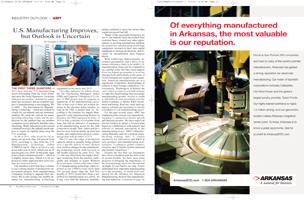
 The first three quarters of 2011 have seen the U.S. manufacturing sector rebounding from the worst downturn since the Great Depression. Economic indicators are positive, demand for equipment has increased, and government support of manufacturing is encouraging. We at AMT – The Association for Manufacturing Technology – watch key indicators closely for our industry and our customers’ markets. We track the outlook for manufacturing technology orders and the predictions for the markets that our member companies serve, primarily durables manufacturing. While indications point toward continued recovery, the industry needs support to regain its rightful place atop the U.S. economy.
The first three quarters of 2011 have seen the U.S. manufacturing sector rebounding from the worst downturn since the Great Depression. Economic indicators are positive, demand for equipment has increased, and government support of manufacturing is encouraging. We at AMT – The Association for Manufacturing Technology – watch key indicators closely for our industry and our customers’ markets. We track the outlook for manufacturing technology orders and the predictions for the markets that our member companies serve, primarily durables manufacturing. While indications point toward continued recovery, the industry needs support to regain its rightful place atop the U.S. economy.
So far in 2011, order levels for our industry are up more than 108 percent from 2010, according to data from the U.S. Manufacturing Technology Orders (USMTO) report. That is on top of a very good order year in 2010, which was an 85 percent gain over 2009! At this point, signs point toward continued growth -- albeit at a slightly slower pace, which is to be expected as orders approach their more normal, pre-recession levels.
Our members report that they continue to see a strong stream of productivity improvement projects from manufacturing companies looking to upgrade their factories. We’re also seeing very healthy demand for manufacturing technology equipment as we move into 2012.
Two other indicators we follow closely are the Purchasing Managers’ Index (PMI) and Capacity Utilization (CU) Index. A PMI greater than 50 suggests an expansion of the manufacturing sector. This is true even if there are modest declines in the absolute index number, as long as the PMI is greater than 50. According to the Institute for Supply Management’s July manufacturing Report on Business, the PMI registered an index of 50.9 in July, a decline of 4.4 points from June, but still an indicator of expansion in the manufacturing sector for the 24th consecutive month. New orders and production were both modestly up from last month, and employment showed continued growth with an index of 53.5.
The CU rate (the value of production capacity which is actually being utilized over a specific period of time) showed slow positive changes for the manufacturing technology sector, with recovery to full health expected by early 2012. The CU rate was affected by the supply shortages stemming from the massive earthquake and tsunami in Japan. Without those incidents, I believe that June (where U.S. manufacturing technology orders reported in our USMTO were more than 100 percent larger than the first five months of 2010) would have been a watershed for manufacturing as a whole. As it was, even with the disasters, manufacturing continued to grow but slower than experts projected last fall.
Many of the successful businesses we see in our industry have diversified their customer bases, created new sales opportunities in growing international markets, developed new manufacturing technology equipment, invested in their own capital equipment to increase productivity, and focused on strengthening their balance sheets.
With technology improvements, increased automation, and a drive to increase efficiency, there is no doubt U.S. manufacturing firms can be competitive on a global scale, but they need support from our federal government to level the playing field, particularly in the areas of overly burdensome taxation and regulation. American manufacturers are at a significant competitive disadvantage in relation to their foreign competitors. Unfortunately, Washington is behind the curve when it comes to a formal strategy to right this disadvantage and encourage manufacturing growth. Access to credit is still difficult, and uncertainty over the future continues to hinder R&D investment and hiring. Real tax, trade and regulatory reforms are necessary to restore confidence to our manufacturing sector.
For the past several years, AMT has emphasized the crucial role manufacturing plays to sustained economic growth and national security. We have urged our elected leaders to adopt a focused plan based on collaboration with industry and schools to unleash innovation in the manufacturing sector. AMT's Manufacturing Mandate calls for a federal manufacturing strategy that: 1) creates incentives for innovation and R&D in new products and manufacturing technologies; 2) enhances global competitiveness; and 3) builds a better educated and trained "smartforce."
Despite the fact that our lawmakers have been consumed with the debt crisis in recent months, we have seen some progress in bringing the importance of the manufacturing sector into the national spotlight. It’s not hard to see why. Voters understand how important manufacturing is to the economy. A recent poll conducted for the Alliance for American Manufacturing showed that manufacturing was ranked as the most important source of economic strength (by a wide margin over both healthcare and high tech). But voters in the same poll gave both Congress and the President low marks on creating manufacturing jobs. How is the federal government responding?
The Obama Administration’s support of two Mandate-supported initiatives this past summer is encouraging. Launched in June, the Advanced Manufacturing Partnership is a national effort to bring industry, universities and the federal government together to invest in emerging technologies that create manufacturing jobs and boost global competitiveness, particularly in industries critical to national security. The $500 million plan uses existing funds and future appropriations from various federal agencies to boost innovation in manufacturing technologies such as small, high-powered batteries, advanced composites, metal fabrication, bio-manufacturing and alternative engineering.
Also in June, President Obama endorsed a manufacturing skills credentialing system to boost manufacturing jobs growth as part of the Skills for America’s Future initiative. Despite the high number of Americans out of work, manufacturing jobs continue to go unfilled. That is because the factory floor today is very different from what it used to be. It is awash with new technologies and processes that require advanced training and adaptable skills with fewer people needed on the shop floor. We need a “smartforce” of workers who are up to the job. The Skills for America’s Future program is an effort to improve industry partnerships with community colleges to ensure that students are gaining the expertise they need to be successful in today’s manufacturing facilities and have the ability to adapt to an ever-changing work environment.
Unfortunately, the impact of these new initiatives is diminished by the anticompetitive business environment in which American manufacturers must compete. Until we take steps to level the playing field for U.S. companies in the global marketplace by eliminating trade barriers, reining in regulations, and lowering taxes for manufacturers, we will continue to lose ground to our foreign competitors in new markets and industries. Yes, manufacturing is rebounding. However, we must keep the pressure on our elected officials to come up with a focused plan for moving forward. Continued growth in our manufacturing sector is a necessary step on the path to sustainable economic prosperity and worldwide leadership and only achievable through the concerted, collaborative efforts of the stakeholders.
For a copy of AMT’s Manufacturing Mandate, visit www.AMTonline.org.


